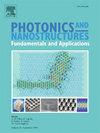Unveiling the potential of non-toxic Ge based perovskite material for all inorganic solar cells using multiple ETLs
IF 2.9
3区 物理与天体物理
Q3 MATERIALS SCIENCE, MULTIDISCIPLINARY
Photonics and Nanostructures-Fundamentals and Applications
Pub Date : 2025-07-08
DOI:10.1016/j.photonics.2025.101425
引用次数: 0
Abstract
This study optimizes all-inorganic Pb-free CsGeI3-based perovskite solar cells. CsGeI3 forms four structures with four electron transport layers (ZnOS, BaSnO3, PC61BM, and ZnSe) and one hole transport layer of Copper Tin Ferrite Sulfide (CFTS). The thickness of the absorber layer is optimized by assessing the effects of the electron transport layer and hole transport layer thicknesses, along with the acceptor and defect densities in the absorbers, donor and defect densities in the electron transport layers, and acceptor and defect densities in the hole transport layers. After optimization, the FTO/ZnOS/CsGeI3/CFTS/Au configuration achieved optimal performance with a VOC of 1.07 V, JSC of 24.39 mA/cm², FF of 82.49 % and efficiency of 21.72 %. The influences of series and shunt resistance, temperature, voltage-current density, quantum efficiency, and generation and recombination rates are examined to determine structural stability. This study aims to improve understanding of CsGeI3-based perovskite solar cell’s experimental research potential.
揭示了无毒的Ge基钙钛矿材料在使用多个etl的所有无机太阳能电池中的潜力
本研究优化了全无机无铅csgei3基钙钛矿太阳能电池。CsGeI3形成4个电子传输层(ZnOS、BaSnO3、PC61BM和ZnSe)和1个铜锡铁酸硫(CFTS)空穴传输层的4种结构。通过评估电子传输层和空穴传输层厚度的影响,以及吸收层中的受体和缺陷密度、电子传输层中的供体和缺陷密度以及空穴传输层中的受体和缺陷密度来优化吸收层的厚度。优化后,FTO/ZnOS/CsGeI3/CFTS/Au结构的VOC为1.07 V, JSC为24.39 mA/cm²,FF为82.49 %,效率为21.72 %,达到了最佳性能。测试了串联和并联电阻、温度、电压电流密度、量子效率以及产生和重组速率的影响,以确定结构的稳定性。本研究旨在提高对csgei3基钙钛矿太阳能电池实验研究潜力的认识。
本文章由计算机程序翻译,如有差异,请以英文原文为准。
求助全文
约1分钟内获得全文
求助全文
来源期刊
CiteScore
5.00
自引率
3.70%
发文量
77
审稿时长
62 days
期刊介绍:
This journal establishes a dedicated channel for physicists, material scientists, chemists, engineers and computer scientists who are interested in photonics and nanostructures, and especially in research related to photonic crystals, photonic band gaps and metamaterials. The Journal sheds light on the latest developments in this growing field of science that will see the emergence of faster telecommunications and ultimately computers that use light instead of electrons to connect components.

 求助内容:
求助内容: 应助结果提醒方式:
应助结果提醒方式:


